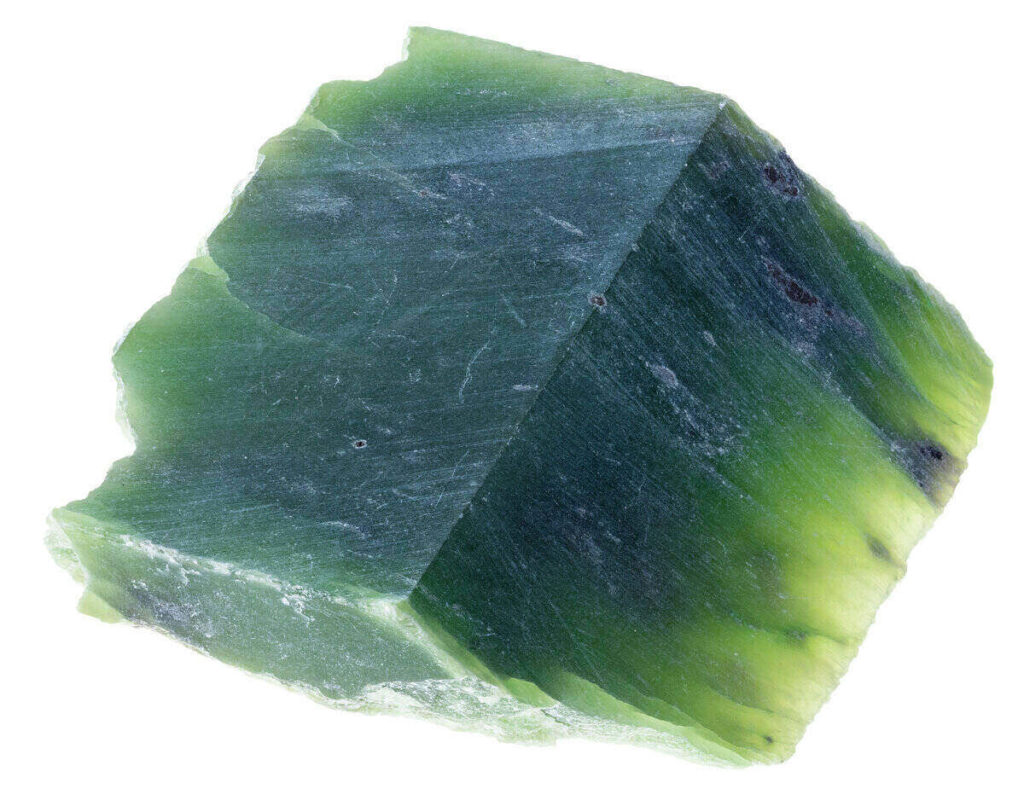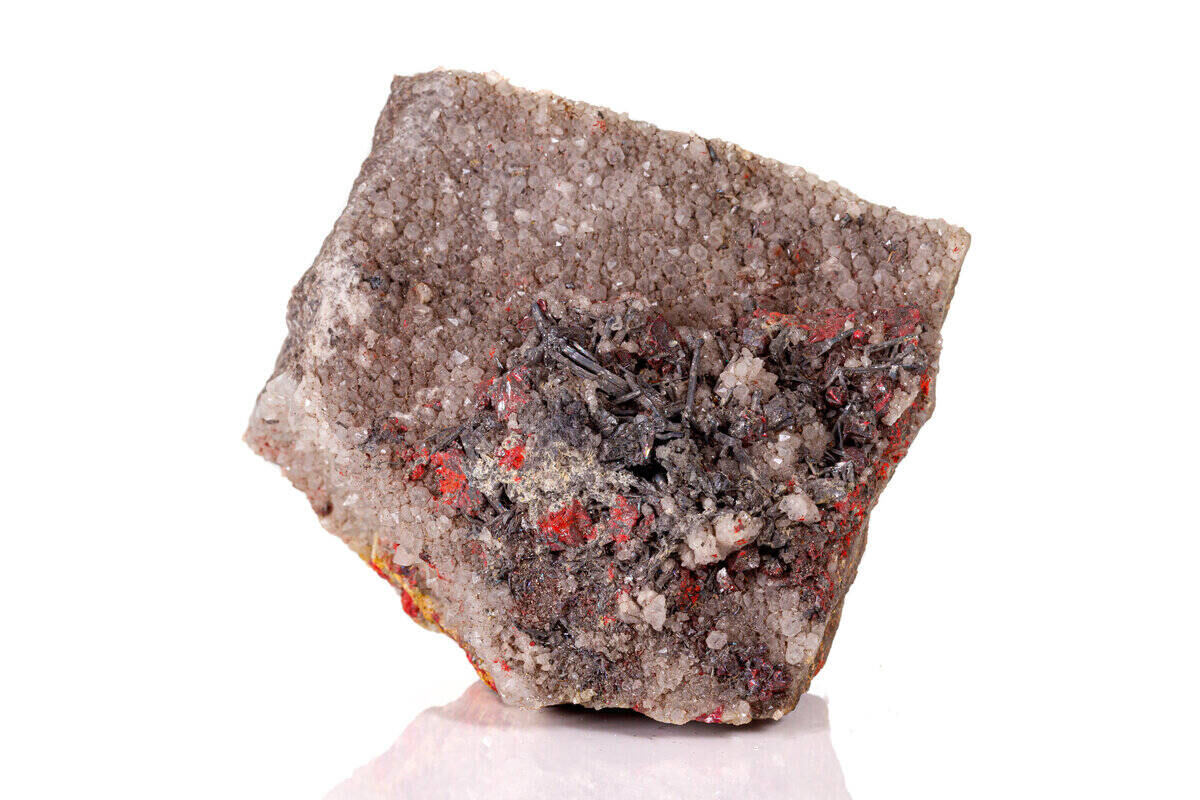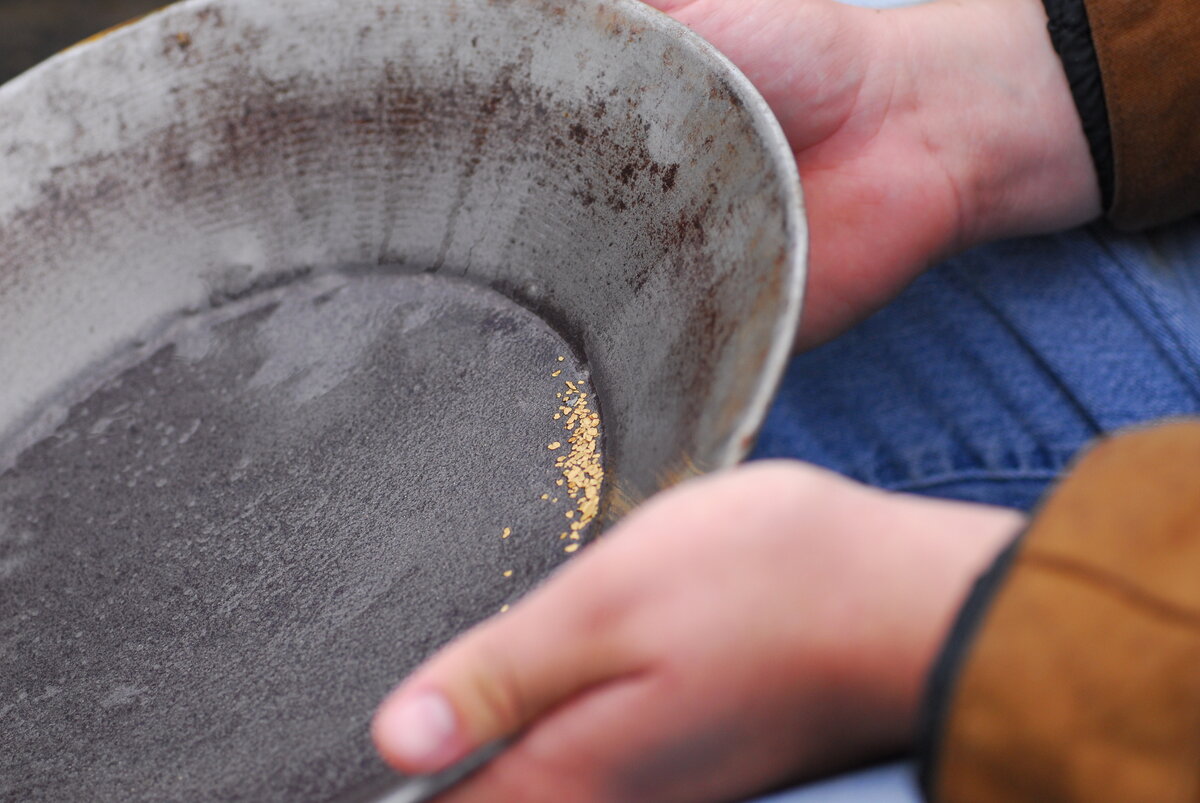Alaska can be a great state for rockhounding, and with its relatively unique challenges come equally rewarding results. With so much public land available for prospecting and exploration you can most likely find some great, unspoiled sites on which to do some rockhounding.
The obvious challenges with rockhounding in Alaska are the weather and inaccessible terrain. When the ground is covered in snow it makes finding any interesting rocks and minerals nearly impossible, and even when there is no snow the ground may still be frozen making it hard to dig. Most of Alaska is challenging and expensive to access, so if you are interested in doing any serious prospecting you should be highly experienced and prepared.
That being said, there are plenty of places to do some more recreational rockhounding. The state of Alaska and the BLM have set up several locations specifically designed for this purpose, and, of course, panning for gold is one of the most popular outdoor hobbies in this part of the country. It helps to have an idea of where to look and what you can find there, so I’ve put this article together to help get you started.
In general, the best places to rockhound in Alaska are the gravels of streams, rivers, and beaches, particularly in the south. Jade Mountain is famous for its jade specimens, and Garnet Ridge is a reliable location to find garnets. Panning for gold in Alaska’s many rivers and streams is also quite popular.
| State Symbols | |
|---|---|
| State Mineral | Gold |
| State Rock | — |
| State Gemstone | Nephrite Jade |
| State Fossil | Woolly Mammoth |

I’ll dive deeper into the types of material you can find here and exactly where you can being your search, along with a handy map and some additional resources to help you along the way.
Rocks and Minerals Found in Alaska
Due to Alaska’s immense size and diverse geology, there is almost no limit to the varieties of rocks and minerals you can find here. In addition to typical common rock types like granite, schist, and sandstone, there are countless mineral species within Alaska’s borders.
The mining history of Alaska is primarily focused on precious metal ores, targeting the production of gold, silver, copper, platinum, and other precious metals. Gemstone mining has been somewhat of a secondary activity here because of the harsh terrain and weather, but the potential for more gemstone production is enormous.
One gemstone that Alaska is famous for is nephrite jade, which is predominantly found in northwest Alaska. The aptly named Jade Mountain and the surrounding area are home to some of the highest quality jade in the world.
The most commonly found and collected rocks and minerals in Alaska are:
- Gold
- Petrified wood
- Nephrite
- Quartz
- Agate
- Jasper
- Cinnabar
- Stibnite

If you’ve already found a rock and you’re not sure what it is, I would highly recommend checking out my Practical Rock Identification System. This bundle of information includes a book, videos, and online tools. It is, simply put, the most comprehensive and easy-to-understand rock identification system you’ll find anywhere.
You can also read through my free rock identification guide and mineral identification guide which are filled with useful information and tools.
Where to Rockhound in Alaska
Important Disclaimer: I have not been to these locations myself, and I do not know if they are currently open for collecting. Use this resource as a guide to get you started. Follow posted signage and always get permission from the landowner to collect.
Through quite a bit of research and cross-referencing of available literature, I have compiled this list of some prospective locations in Alaska which I would recommend to people looking to do some rockhounding. These are mostly comprised of beaches, outcrops, old mining prospects, washes, streams, and historically known rock and mineral collecting sites. For additional reading, I’d highly recommend these books you can find on Amazon:
Please remember that rock collecting locations are constantly changing. Specimens may become depleted from other collectors, the location may have been built on or altered, locality information in literature may be inaccurate, and property ownership may have changed hands. Please note that I have not been to these locations. I have found records of these rockhounding sites over a variety of sources and offer these locations as a place to start searching. I cannot personally attest to the accuracy of the given locations or the quality of the material there.
Joining up with a local rockhounding club for a group trip can often get you access to otherwise off-limits locations like privately owned mines and quarries. There are several rockhounding clubs in Alaska so, hopefully, you can find one you like nearby.
I have tried to take care not to list locations within National Park boundaries since collecting is illegal there, but please remember that it is up to you to make sure you have permission to collect wherever you are. Even if you are on land that is generally open for public use there may be privately owned mining claims inside those boundaries and you’ll need to get permission to collect on that location.
Though there are many locations listed here, this list is far from exhaustive. A location’s listing here is not a guarantee of accuracy. Be safe, never go underground, and make sure to get permission from the landowner to search for and collect specimens.
If you’re planning on heading to the field, make sure you have all the gear you’ll need! To get started, you can check out my recommended gear page which contains my full reviews for every Geologist’s favorite rock hammer and the best hiking backpack I’ve ever owned.
Some of the best rockhounding sites in Alaska are privately owned. Some are commercially operated mines and quarries, and gaining permission to collect on any of these properties is, as always, absolutely essential. Some are open to the public for collecting at select times of the week, often on weekends. I will have more information on how to check property ownership status later in this article.
Bristol Bay & the Aleutian Islands
Rockhounding in the Bristol Bay area is highlighted by the placer gold deposits found in most of the local rivers and lakes. You can also find some cinnabar along the Wood River and petrified wood in the gravels around Kujulik Bay. There are also reports of other quartz family minerals like agates, bloodstone, and carnelian in several locations near Bristol Bay.
Tip: Check out my Complete Rockhounding Guide for tips on planning your rockhounding trip and getting the most out of your time in the field!
The Aleutian Islands aren’t exactly a hotspot for rockhounding because of the obvious difficulties involved in even getting to them, but if you happen to be heading that way there is some interesting material to be found in the right places. The gravels of island beaches will typically hold some agates and high-quality jasper.
| Location & Details | Rocks & Minerals |
|---|---|
| Bristol Bay, in gravels and prospects along the Wood River | Cinnabar |
| Kujulik Bay, general area in gravels | Petrified wood |
| Iliamna Lake, in inflowing streams as placers | Gold |
| Lake Clark, in inflowing streams as placers | Gold |
| Becharof Lake, on N shore | Carnelian |
| Lake Iliamna, on beaches | Agate, Bloodstone |
| Port Heiden, area beach gravels to SW | Agate |
| Adak Island, on N shore in beach gravels | Jasper (red, gem-quality) |
| Atka Island, general area | Petrified wood |
| Attu Island, beach gravels on SE side | Chalcedony and Jasper pebbles |
| Kodiak Island, W coast beaches | Copper, Gold, Lead, Silver, Tin, Zinc |
| Sand Point, Shumagin Islands in beach gravels | Agate, Carnelian, Chalcedony, Jasper |
| Tanaga Island, in beach gravels | Agate (pebbles) |
| Unalaska Island, in gravels near Dutch Harbor | Agate (banded, gray), Chalcedony, Argillite, Jasper (green) |
Alaskan Interior
The Alaskan Interior and the Yukon River Basin are famous for placer gold deposits. Almost any river or stream will turn up some amount of placer gold if the proper techniques are applied. Mining districts all over the area’s many mountain ranges have historically produced minerals like stibnite, cinnabar, and ore minerals.
| Location & Details | Rocks & Minerals |
|---|---|
| Eva Creek, as float near Liberty Bell Mine | Ferberite, Gold, Lead, Silver |
| Mt. Hayes, N slope near Ferry | Stibnite |
| Fairbanks, in placers over a large area | Gold, Antimony, Tungsten |
| Fairbanks, in area stream gravels | Stibnite, Gold, Quartz, Fossils, Cassiterite |
| Healy, general area in gravels and exposures | Amethyst, Agate, Quartz |
Northwest Alaska
If you’re looking to do some rockhounding in northwestern Alaska you’re braver than me! This region is inhospitable and dangerous without the proper precautions, but does offer ample rewards for those who can manage the conditions.
The area surrounding Jade Mountain (including Jade Creek) is among the most famous places on earth for high-quality nephrite jade production. The gem-quality material found here is highly sought-after and often used for carving and lapidary work.
| Location & Details | Rocks & Minerals |
|---|---|
| California Creek and other area streams, as float | Asbestos, Serpentine |
| Dahl Creek, area outcrops | Chrysotile |
| Asbestos Mountain, in outcrops near summit | Chrysotile, Asbestos, Tremolite, Serpentine, Magnesite, Magnetite, Nickel |
| Jade Creek, general area | Nephrite jade |
| Shungnak, general area | Gold (in placers), Platinum, Asbestos, Nephrite jade, Serpentine |
| Squirrel River and tributaries, in placers near Kiania | Gold, Platinum |
| Jade Mountains, all area creeks and gravels | Nephrite Jade (gem-quality) |
| Point Barrow, in some beach deposits | Amber |
Southwest Alaska
Rockhounding in southwest Alaska is mostly limited to the ample placer gold found in the many rivers and streams that cut through the landscape, particularly along the Kanektok and Togiak Rivers and their tributaries. For a bit more variety, you can search for fossilized ivory in gravels and washes near Cape Newenham.
| Location & Details | Rocks & Minerals |
|---|---|
| Kanektok River, general area, in placers | Gold |
| Togiak River, general area, in placers | Gold |
| Goodnews mining district, placers over a wide area | Gold, Platinum |
| Platinum, general area near Cape Newenham | Fossil ivory |
| Sleetmute mining district, area deposits | Cinnabar |
Seward Peninsula
The Seward Peninsula is among the richest regions in the entire world for placer gold deposits. The rivers and streams in the area are famous for their placer gold, and even wash enough gold into the ocean to create rich placer deposits on the ocean beaches.
| Location & Details | Rocks & Minerals |
|---|---|
| Bendeleben Mountains, area pegmatites | Muscovite |
| Aggie Creek, in placers | Gold |
| Kotzebue Sound, on S shores | Fossil ivory |
| Dime Creek and other area creeks, in placers and prospects | Gold |
| Gold Run and most other creeks and rivers on W peninsula | Gold |
| York, area placers | Cassiterite, Gold |
Southeastern Alaska
There is a bit more variety in southeastern Alaska compared to the rest of the state when it comes to rockhounding. This is probably largely due to the (relatively) high population and therefore more thorough prospecting. Working the many area placer gold deposits is still the most popular activity for amateur geologists, but there are many other locations to check out where you can find some gemstones and other interesting minerals.
One of the most popular rockhounding locations in Alaska is Garnet Ledge, south of the mouth of the Stikine River. This land is owned by the Boy Scouts and is free for children to collect on, but adults are required to purchase a permit for a small fee. The garnets are typically harvested out of schists and picked out of the nearby talus.
You can also pick through the gravels of many local bays and rivers for minerals like agates, petrified wood, and jasper. These specimens are fun to find and would make nice additions to most collections, but aren’t particularly notable for their quality or uniqueness.
| Location & Details | Rocks & Minerals |
|---|---|
| Archangel Creek, near head | Gold |
| Craigie Creek, near head and near Willow Creek | Gold |
| Willow Creek, near head | Gold |
| Matahuska River, along Glenn Hwy. | Jasper |
| Fire Island | Agate |
| Kenai River & area to S | Agate, Jasper |
| Anchor River, general area | Petrified wood, Agate |
| Haines, E side of Chilkat Valley in deposits | Barite, Gold, Magnetite |
| Admiralty Island, on beaches from Wilson Cove to Point Gardner | Agate |
| Moose Pass and Hope mining districts, S of Anchorage | Gold |
| Crow Creek Gold Mine | Gold |
| Salamtof Beach, in gravels | Agate |
| Lituya Bay, in beach placers | Gold |
| Glacier Bay (no collecting) and Hamilton Bay, in beach gravels | Agate, Jasper, Petrified wood |
| Red Bluff Bay, area gravels | Serpentine |
| Silver Bay, near head SE of Sitka | Rhodonite |
| Garnet Ledge, SE of Stikine River Mouth | Garnet (almandine) |
| Saginaw Bay, in beach gravels | Agate, Jasper, Petrified wood |
| Port Houghton, area to S | Garnet, Tourmaline |
Panning for Gold in Alaska

Panning for gold is one of the most popular outdoor hobbies in Alaska. The geology and topography of the region combine to make rivers and streams all over the state some of the best places you can pan for gold in America. Combine that with the fact that approximately 99% of Alaska is public land and it’s easy to see why the hobby is so popular.
You can find some prime locations to pan for gold in the tables I listed above, but for families or beginners just getting into the hobby, there are a few locations specifically designated for recreational gold panning by the Alaska Department of Natural Resources. These sites are a great way to have fun, learn about the hobby, and reliably find some gold flakes without having to worry about mining claims or land ownership issues.
The best places to pan for gold in Alaska are:
In general, gold panning is permitted on state land and BLM land throughout Alaska as long as you aren’t on someone else’s mining claim. Only hand tools are allowed for recreational prospecting, but you may be able to procure a permit to use heavier equipment like dredges.
Alaska Rockhounding Laws & Regulations
One of the most common questions rockhounds have is whether or not they are allowed to collect at a certain location. It is the responsibility of each rockhound to obtain permission from a landowner to search and/or collect on a piece of property.
The ownership and status of land can and does change frequently, making it impossible to document accurate information for every location on this page. However, I have compiled a list of resources here so that you may investigate and obtain permission for any locations (found here or elsewhere) for yourself.
Public Land Resources
I have written entire articles which cover the rockhounding laws and regulations for nearly every type of public land you can think of. I encourage you to check them out if you are curious about the legalities of rock and mineral collecting.
- Rockhounding on Public Land: Laws and Regulations
- Can You Collect Rocks in State Parks? All 50 States Answered
To determine what type of public land a particular location is on, I would recommend starting with the maps from the Alaska Department of Natural Resources where you can view things like land ownership, mining claims, geologic maps, and more.
Here are some additional resources to help you check on land ownership and mineral claims:
- US Forest Service Interactive Map
- BLM’s Mineral Land and Records System – to check for mineral claims
Private Land Resources
As with most states, each borough in Alaska will have records of who owns each piece of property. You can also usually get the landowner’s name and address by contacting the borough’s records office. I would probably start by doing a property records search and getting whatever contact information you can for the landowner.
Sources & Further Reading
The locations and information contained in this article are primarily derived from academic papers, online resources, and other outside sources. If you would like to read some of the source material for yourself I have listed them below. The majority of these locations are my interpretation of Robert Beste’s A Location Guide for Rock Hounds in the United States. Other sources include:
- mindat.com
- Mineral Resources Data System
- Alaska Geological Survey
- Alaska Department of Natural Resources
- Alaska Geological Maps
- Alaska Rocks and Minerals
- Recreational Gold Mining in Alaska
- Alaska Miners Association
This post is part of my State-By-State Rockhounding Guides series. Please check out more states for thousands of additional sites to go rockhounding!
